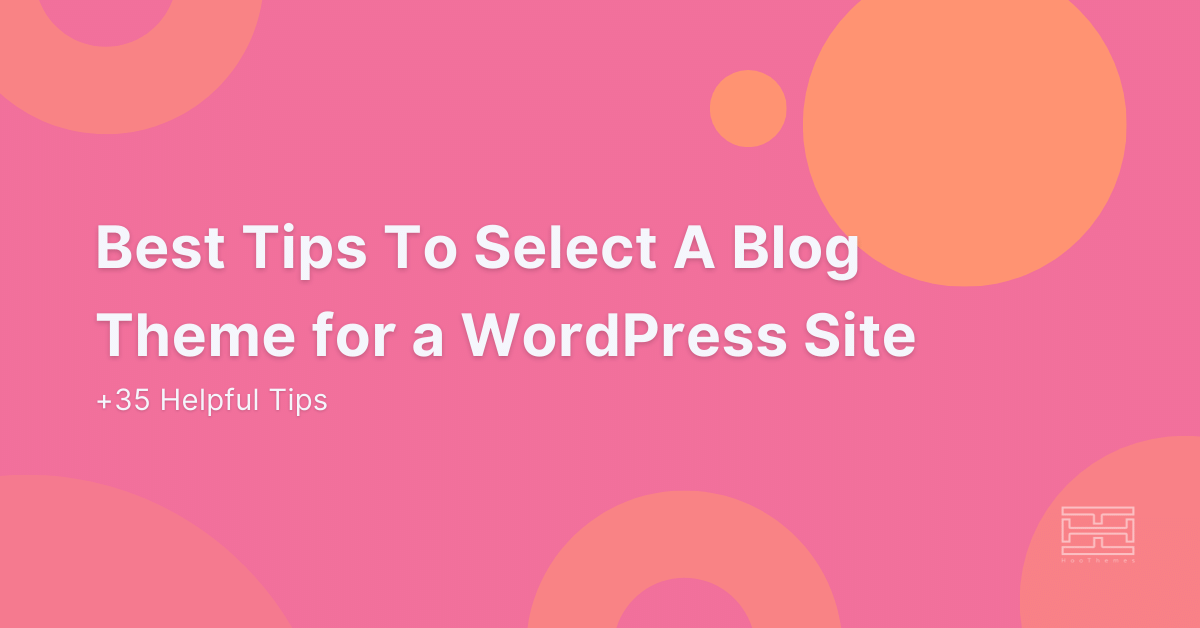WordPress themes are here to make it easy for you to own a website by offering practically every fundamental website part pre-built and integrated and only leaving the customization according to your business, niche, target audience preferences, and personal taste and vision up to you. That sounds like a delicious combo, right?
But be mindful that every free reign in life means being left to make many decisions on your own, every single one of which will directly impact whether you make it or not.
So basically, you need to know what you are doing in the selection process, and you need to know what features you need to look for in choosing a WordPress theme, but that’s not enough either.
You need to be familiar with the best tips to select a blog theme from industry veterans on what is essentially important and how to incorporate those important tips and factors in choosing a WordPress theme.
39 Best Tips To Select A Blog Theme for Your Website
If you are a blogger, or your website will closely reflect blog-type content and style, this is especially aimed at helping you, as here we will be summarizing the best tips to select a blog theme in WordPress. Read up, and keep every single one of the pointers in mind when choosing your blog theme.
1. Smooth UX is Key
What is UX? And how can it be smooth? Standing for “user experience,” UX is concerned with how easily and effectively a user interacts with a website’s content and different elements. It involves the fundamental features the theme you are choosing offers, how the developers have designed the features, elements, layouts, and customization styles can make the user’s experience smooth, convenient, fruitful, and satisfactory; or utterly unworkable, unusable, inconvenient, and a nuisance.
Here are some elements of a smooth user experience you need to look for in any theme, especially a blog theme, followed by the best tips to select a blog theme with good UX.
1.1 Easy Navigation
You need a neat dividing and organization system for your content. You need to have a table of content, a menu to list the different categories if you have them, and a separate easily-found place for everything. Long story short, users should find it super easy to navigate herself/himself through your content.
1.2 Visual Hierarchy
We have all been to a few news sites or blog sites of different sorts, which are mostly entertainment news and tabloid-type sites, where we instantly cringe as we are inflicted with a confused, patchy-looking, jumbled pile-up of images, videos, and blog posts, and the promise of a good experience on that site is instantly gone out the window.
Most of us leave immediately if we don’t have to stay. One of the best tips to avoid that is to have a visual hierarchy. So keep that in mind when going through the layouts of your theme, especially if it is a blog theme.
1.3 Color Contrast
One of the big elements of a good user experience on any site is to be able to see and find things easily; pretty basic, right? But many website designers lose that simple yet very effective quality by choosing foreground and background colors that do not have enough contrast, so something as basic as a visual division of parts and elements becomes challenging.
One strategy is trying to use as much white space as possible to create enough color contrast so we can tell apart two neighboring content parts on your website at the first glance.
You can tell the bottom-line in user experience is neatness, easy visual recognition, and simple routes from the starting point to the ultimate destination, so try to uncomplicate your user’s experience by:
- Putting things in obvious places and plain sight
- Avoid clutter
- Avoid distracting color combinations.
2. Simplicity Goes A Long Way
If you are one of those “more is more” people and have always found yourself disagreeing hard with “less is more” folk, we are here to tell you it’s better that you rethink your policy, at least in choosing a WordPress theme, especially for a blog theme. Here’s why:
2.1 The Frustration Factor
Studies have shown that busy themes stuffed with unnecessary elements won’t impress; they frustrate. Before your audience gets a chance to find all the luxuries on your website impressive, they have long been frustrated by the utter clutter.
2.2 The Sophistication Factor
Simpler, less luxurious-looking designs have proven more successful with the blog reading types, which constitute a good portion of the website users of current times; as they are mostly believers in substance versus glitter, they’ll equate simplicity with sophistication and will take you more seriously if your style is simpler. You are presenting your material to a “less is more” crowd, so design accordingly.
2.3 The Distraction Factor
Put simply, less busy is less distracting. You want your audience to keep coming to your site for its content and engage with it, right? So by putting a variety of ultra-stylish elements everywhere, you’ll preoccupy your audience and distract them from your focal point being your content.
2.4 The SEO Factor
Simple themes have taken shorter and fewer codes to be created, so naturally, they’re lighter, and they take a lot less time to load, which is a huge plus on its own. What’s more, as a result of fast-loading, a website will be more SEO-friendly for all types of websites and especially closer to blog post SEO standards, which you will find out more about right below.
3. SEO-Friendliness Is A Great Friend
SEO, an abbreviation for Search Engine Optimization, is a combination of factors that Google’s indexing algorithms/robots consider to decide whether your site is worth showing to users who are googling your business’s keywords. So if your theme or website is not SEO-friendly, it will not appear on top of the search result pages, and your content won’t find enough audience.
Now, if you are a blog website generating revenue by subscriptions or selling products of your niche, you will lose business by not having enough customers, and if you are a free website providing free information and news, you will lose the money you can make through selling advertisement spaces. So, that’s why SEO-friendliness is one of the best tips for selecting a blog theme and every other site type.
4. Premium Theme Benefits Help A Lot
Sounds rather obvious, but a premium theme will prove better than the free ones, owing to a three-fold reason:
4.1 Support Staff
Most of us are real beginners with tech stuff, and we are bound to run into glitches and complications along the way of creating pages, selecting elements, customizing, and the like. So, we are going to need the help of a dedicated, patient, and tech-savvy support staff, which is a feature almost exclusively provided by premium themes.
4.2 Fewer Bugs and Glitches
Those themes that charge you to let you use their product can afford to pay a skilled staff working full time on going through every single feedback, and troubleshooting any possible bug, so with a premium, you’ll get far fewer bugs and troubles.
4.3 Frequent Updates
As a result of working on the possible bugs or inconveniences that users of a theme report, the well-paid developers of a theme release new updates quite frequently, so you’ll not only get new features rather frequently, you won’t have to wait months or years to get rid of a minor hitch or a major hindrance in your website.
So you see why paying a relatively small fee for a premium theme is one of the best tips for selecting a blog theme.
5. Mobile Friendliness is Crucial
You’ll need three features to have a fully up-to-par mobile-friendly theme.
5.1 Mobile Responsiveness
When a theme is called mobile responsive, it means it was primarily designed for a desktop size, but it is later coded into fitting its features in smaller mobile and tablet screen sizes without jumbling them up. In other words, the elements of a website are secondarily made able to keep their positions when screen sizes get smaller.
It’s safe to say every user has stumbled into a few websites on their phones where half of the page can’t be seen or the entire page is muddled up on the lower left side; those websites are not mobile-responsive.
5.2 Mobile-first Design
In a mobile-first design, as the title suggests, the process is the exact opposite, the mobile-fitting feature and element arrangement is done first, and it is made responsive to larger desktop sizes second.
5.3 AMP System
It stands for Accelerated Mobile Pages, and it is a method of display that is designed to remove any unessential cluttering script from a page, enabling it to load considerably faster.
So while being mobile-responsive and mobile-first is about aesthetics and user experience, AMP is about speed. Now, there was a time when being mobile responsive was a plus, but today it is simply not enough. Why?
Why Should You Care About Mobile-First And AMP-Integrated Features? The SEO and software developer’s consensus: you’d better take care to find themes that come with the mobile-first and AMP systems. But why should you care?
First: Because Google Does
Google has signaled in the two following ways that it cares greatly whether your website has these two features or not, and it is going to reward those who have them and punish those who don’t.
- A. Mobile-First Indexing Algorithm
In 2019, Google introduced its mobile-first indexing algorithm, which means it trained its robots to look for the websites that have the mobile-first and AMP systems, identified them as more user-friendly and audience-pleasing, gave them higher SEO scores, and took them higher in the search engine results. Do you want a hint more obvious than that?
- B. AMP Has A Dedicated Section In The Google Search Console
Google not only co-developing this feature itself, but it also double-emphasized its importance by dedicating a separate section on its search console to AMP pages.
Second: Because Your Users Care.
With a mobile-first design and AMP speed, you will be giving your users an ultra-convenient, uber-fast, perfectly satisfactory experience on your website that works to your advantage on multiple levels: it gets you a great word of mouth, more clicks, longer stays on your website, lower bounce rates, and greater SEO.
So, you see why making sure your theme has mobile-friendly features is one of the best tips to select a blog theme.
6. Easy And Option-Filled Customization
Some themes are designed to give you convenience in building up your page to represent your vision well, but they lack some pretty significant features. On the flip side, some pages that give you a host of options can be clunky in the customization process.
So you need to look for themes that bring you a smooth experience of designing your page and will bring your users an equally smooth experience in navigating and interacting with your website. So one of our best tips to select a blog theme is advising you to look for the following in the customization features of a theme, especially a blog theme or a blog-natured/blog-like theme.
6.1 Page Builder
Do not underestimate the significance of a powerful built-in page builder. You will need to build many new pages quickly and easily to have a more than adequate website in your niche.
6.2 Variety Of Pre-Built Layouts
You will need a large range of different layouts to choose one that portrays how you want to be perceived, you’ll need nuances, you’ll need subtle differences, and you’ll need options. So, the more layouts a theme has, the higher will the odds of your visions being represented well will go
6.3 Widgets Or Blocks For Adding Features
Some features are the basic parts of any website, and some are specifically needed for your line of work or area of interest. You need to ensure your blog theme has the core widgets, costume widgets, or Gutenberg blocks for both, or you’ll be amiss in providing what makes you enough and special.
6.4 Easy, Straight-Forward Navigation
There are several options you have to facilitate trouble-free navigation of your website:
6.5 Side Bar
A sidebar will give the list of your blog posts a neat arrangement in a place where everyone can find it and work it.
6.6 Mega Menu
There has been a “mega menu, to use or not to use” debate among the website-designing community for a while. Here’s the bottom line: if the number of your categories goes into double digits, and they each have some subcategories, you’ll need a mega menu to keep them in check, but if it doesn’t, a mega menu will be showily excessive and will create unnecessary lag, killing your lightness and speed.
6.7 Portfolio Layout
Many would argue a portfolio layout is the best system for a blog theme, as not only it’s visually pleasing and well-ordered, it lets the user keep track of what he wants in one full framework. It’s seen as the perfect combo for a blog theme; that’s why it is advised in most of the advice columns on the best tips to select a blog theme.
6.8 Social Media Syncability
We live in the era of social media, so however big your presence is in the real world or even in the internet world, if you are not seen or talked about on social media, especially Instagram, you will lag behind your competition. So you need a blog theme that can be synced with social media easily, and this is easily one of the best tips to select a blog theme anyone can give you.
6.9 RSS Feed
You can benefit greatly from putting an RSS, Really Simple Syndication system, where an email alerts your audience with your latest posts.
6.10 Subscription
Make sure there is a subscription widget on your blog theme, as your target users will want one.
6.11 Bookmarking
Every blogging website strives to write blog posts that their patrons will want to keep and read again, so a bookmarking feature is a must for your blog theme.
6.12 Share Button
Easy content sharing is key for a blog website, as the modern blog post reader would be super eager to share what they read and like with their social circle, peers, friends, and so forth.
6.13 Audience Participation Tools
You will want audience participation tools like a forum-type comment section and a rating and reviewing the section on your blog theme. There are three reasons why having them is essential:
- A. They’ll Boost your Panda Algorithm Friendliness
Many sites just try to give Google algorithms what they want, to fool it into raising their SEO scores, for example, through content farming. Google introduced the Panda algorithm in 2011 to distinguish popular interactive sites from fake ones. What can boost your panda score is showing Google people are interacting with your site, which is made possible by participation tools for leaving comments and having discussions.
- B. Keep Users On Site Longer
People will stay longer when they are leaving a comment and having heated discussions about your blog posts, which is one of the top items on your website success checklist.
7. Multi-Purpose Theme vs. Blog-Specific Themes
There are two types of themes, mega multi-purpose themes which provide a couple of business-specific themes and layouts for different businesses and niches, and business-specific themes, which target the particular needs of a specialized line of work or interest. You should check out both of them, as both are designed by people fully familiar with your industry who know what you’ll want and need. Just go through their layout selection carefully and look for your business-specific features.
8. Multi-Browser Compatibility
Your audience may be using browsers like Chrome, Firefox, and Opera…to click into your site, so you need a theme, or more specifically, a blog theme that is compatible with all browsers out there, or you’ll lose some patrons. and make sure you remember this since it’s often overlooked and not included in articles that claim to have the best tips to select a blog theme.
9. Multilingualism
The final tip among the best tips to select a blog theme is the theme supporting multilingualism. You are far safer to pick a blog theme that has a translation feature built-in since:
9.1 You Want To Think International
We have long stopped living in a locally-impacted world, as large-scale immigration, multi-ethnic communities, and universally shared social media have rendered our blog audience into an international one. So providing content in a couple of languages will win you an incomparably larger and more satisfied audience.
9.2 Your SEO Will Suffer If You Add It Later
Many think nothing of being multilingual at first, thinking they can always add a plug-in later, but Google won’t index auto-translated pages in the search results, so your SEO will be hurt if you decide you want to go beyond a local scope and go international
9.3 It’s Quite Impressive
Presenting content in several different languages will put you in a remarkably higher caliber of blogging websites, and it will build you considerable credit with the reader crowd.
9.4 Language Learning Appeal
Blog post target audiences are mostly the educationally-ambitious types who have been proven to be language learning enthusiasts. Providing the same content in different languages will appeal to many as a learning experience that will be added to the already long list of your appeals, which can never hurt.
Wrapping Up All The Best Tips To Select A Blog Theme
To give you a thorough enough list of the best tips to select a blog theme, we need to make sure you are aware of all that will matter in the triumph of your online presence attempts.
From a smooth user experience made possible by simplicity to good SEO practices made possible by speed; making sure your blog theme features are mobile-optimized to taking care you have all the necessary features to keep your audience participating and updated; we have tried our best to keep you well-informed on everything, you need to know to select a blog theme that facilitates running an accomplished blogging website.
So make sure you go through every part with great attention so you won’t miss any important bit of our comprehensive list of best tips to select a blog post.
Read more:
- +25 Best WordPress Restaurant Themes To Consider For Your Restaurant
- Elementor Popup Builder: An Overview [+Top 5 Features]
- 14 Popular Blog Format Types to Boost Reader Engagement
- WordPress Website Design Guide [+10 Bonus Tips]
- 14 Best Simple WordPress Themes in 2022 [+Minimalist Themes]



![Read more about the article Best WordPress Plugins for New Websites [25 Plugins]](https://www.hoothemes.com/wp-content/uploads/2021/09/Best-WordPress-Plugins-for-Newly-Launched-Websites-1-300x182.jpg)


![Read more about the article What is a Microsite in 2022? [+Important Pros & Cons]](https://www.hoothemes.com/wp-content/uploads/2022/09/What-is-a-Microsite-in-2022-Pros-Cons-300x157.png)


